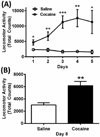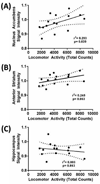Cocaine-induced locomotor sensitization in rats correlates with nucleus accumbens activity on manganese-enhanced MRI
- PMID: 26411897
- PMCID: PMC4618766
- DOI: 10.1002/nbm.3409
Cocaine-induced locomotor sensitization in rats correlates with nucleus accumbens activity on manganese-enhanced MRI
Abstract
A long-standing goal of substance abuse research has been to link drug-induced behavioral outcomes with the activity of specific brain regions to understand the neurobiology of addiction behaviors and to search for drug-able targets. Here, we tested the hypothesis that cocaine produces locomotor (behavioral) sensitization that correlates with increased calcium channel-mediated neuroactivity in brain regions linked with drug addiction, such as the nucleus accumbens (NAC), anterior striatum (AST) and hippocampus, as measured using manganese-enhanced MRI (MEMRI). Rats were treated with cocaine for 5 days, followed by a 2-day drug-free period. The following day, locomotor sensitization was quantified as a metric of cocaine-induced neuroplasticity in the presence of manganese. Immediately following behavioral testing, rats were examined for changes in calcium channel-mediated neuronal activity in the NAC, AST, hippocampus and temporalis muscle, which was associated with behavioral sensitization using MEMRI. Cocaine significantly increased locomotor activity and produced behavioral sensitization compared with saline treatment of control rats. A significant increase in MEMRI signal intensity was determined in the NAC, but not AST or hippocampus, of cocaine-treated rats compared with saline-treated control rats. Cocaine did not increase signal intensity in the temporalis muscle. Notably, in support of our hypothesis, behavior was significantly and positively correlated with MEMRI signal intensity in the NAC. As neuronal uptake of manganese is regulated by calcium channels, these results indicate that MEMRI is a powerful research tool to study neuronal activity in freely behaving animals and to guide new calcium channel-based therapies for the treatment of cocaine abuse and dependence.
Keywords: behavioral sensitization; calcium; cocaine; dopamine transporter; magnetic resonance imaging; manganese; nucleus accumbens; striatum.
Copyright © 2015 John Wiley & Sons, Ltd.
Figures






Similar articles
-
The role of the nucleus accumbens OXR1 in cocaine-induced locomotor sensitization.Behav Brain Res. 2020 Feb 3;379:112365. doi: 10.1016/j.bbr.2019.112365. Epub 2019 Nov 16. Behav Brain Res. 2020. PMID: 31743729
-
Glycogen synthase kinase 3beta in the nucleus accumbens core mediates cocaine-induced behavioral sensitization.J Neurochem. 2009 Dec;111(6):1357-68. doi: 10.1111/j.1471-4159.2009.06414.x. Epub 2009 Oct 3. J Neurochem. 2009. PMID: 19799712
-
Molecular changes in the nucleus accumbens and prefrontal cortex associated with the locomotor sensitization induced by coca paste seized samples.Psychopharmacology (Berl). 2020 May;237(5):1481-1491. doi: 10.1007/s00213-020-05474-3. Epub 2020 Feb 7. Psychopharmacology (Berl). 2020. PMID: 32034449
-
AMPA receptor plasticity in the nucleus accumbens after repeated exposure to cocaine.Neurosci Biobehav Rev. 2010 Nov;35(2):185-211. doi: 10.1016/j.neubiorev.2010.01.013. Epub 2010 Jan 28. Neurosci Biobehav Rev. 2010. PMID: 20109488 Free PMC article. Review.
-
The role of accumbal hypoactivity in cocaine addiction.ScientificWorldJournal. 2007 Nov 2;7:22-45. doi: 10.1100/tsw.2007.266. ScientificWorldJournal. 2007. PMID: 17982574 Free PMC article. Review.
Cited by
-
MEMRI is a biomarker defining nicotine-specific neuronal responses in subregions of the rodent brain.Am J Transl Res. 2017 Feb 15;9(2):601-610. eCollection 2017. Am J Transl Res. 2017. PMID: 28337287 Free PMC article.
-
Striatal miR-183-5p inhibits methamphetamine-induced locomotion by regulating glucocorticoid receptor signaling.Front Pharmacol. 2022 Sep 26;13:997701. doi: 10.3389/fphar.2022.997701. eCollection 2022. Front Pharmacol. 2022. PMID: 36225577 Free PMC article.
-
Cocaine differentially affects synaptic activity in memory and midbrain areas of female and male rats: an in vivo MEMRI study.Brain Imaging Behav. 2018 Feb;12(1):201-216. doi: 10.1007/s11682-017-9691-1. Brain Imaging Behav. 2018. PMID: 28236167 Free PMC article.
-
The Role of BTBD9 in the Cerebellum, Sleep-like Behaviors and the Restless Legs Syndrome.Neuroscience. 2020 Aug 1;440:85-96. doi: 10.1016/j.neuroscience.2020.05.021. Epub 2020 May 22. Neuroscience. 2020. PMID: 32446853 Free PMC article.
-
Traumatic Stress, Chronic Ethanol Exposure, or the Combination, Alter Cannabinoid System Components in Reward and Limbic Regions of the Mouse Brain.Molecules. 2021 Apr 6;26(7):2086. doi: 10.3390/molecules26072086. Molecules. 2021. PMID: 33917316 Free PMC article.
References
-
- Kalivas PW, Stewart J. Dopamine transmission in the initiation and expression of drug- and stress-induced sensitization of motor activity. Brain research. Brain research reviews. 1991;16:223–244. - PubMed
-
- Robinson TE, Berridge KC. The neural basis of drug craving: an incentive-sensitization theory of addiction. Brain research. Brain research reviews. 1993;18:247–291. - PubMed
-
- Kalivas PW. The glutamate homeostasis hypothesis of addiction. Nature reviews. Neuroscience. 2009;10:561–572. - PubMed
-
- Pierce RC, Kalivas PW. A circuitry model of the expression of behavioral sensitization to amphetamine-like psychostimulants. Brain research. Brain research reviews. 1997;25:192–216. - PubMed
Publication types
MeSH terms
Substances
Grants and funding
LinkOut - more resources
Full Text Sources
Other Literature Sources
Medical
Research Materials

